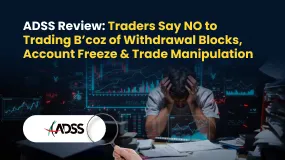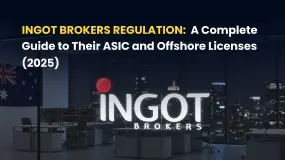简体中文
繁體中文
English
Pусский
日本語
ภาษาไทย
Tiếng Việt
Bahasa Indonesia
Español
हिन्दी
Filippiiniläinen
Français
Deutsch
Português
Türkçe
한국어
العربية
How to Know if the Market is Correcting or Reversing?
Abstract:In trading, distinguishing between a market correction and a market reversal is crucial for making sound decisions. Misjudging one for the other can lead to missed opportunities or significant losses. While both involve price movements, their causes, duration, and implications differ substantially. Understanding these differences can help traders improve their strategies and adapt to market conditions effectively.

In trading, distinguishing between a market correction and a market reversal is crucial for making sound decisions. Misjudging one for the other can lead to missed opportunities or significant losses. While both involve price movements, their causes, duration, and implications differ substantially. Understanding these differences can help traders improve their strategies and adapt to market conditions effectively.

A market correction is a temporary dip in asset prices, often seen after a prolonged upward trend. Corrections typically involve declines of less than 10% and are considered a natural part of market cycles. They allow the market to recalibrate, relieving overbought conditions before resuming its primary trend.
For example, Bitcoin recently surged past the $100,000 mark, driven by investor enthusiasm and strong market sentiment. However, the price subsequently dropped to the $95,000 range. This decline did not indicate a fundamental shift in market dynamics. Instead, it reflected a short-term correction as traders took profits and the market adjusted to the new price levels.
Corrections like this are common and often provide traders with an opportunity to buy assets at more attractive prices, anticipating a continuation of the overall trend.

In contrast, a market reversal signals a significant and sustained change in the markets direction. It occurs when an uptrend transitions into a downtrend or vice versa. Unlike corrections, reversals are not temporary pullbacks but indicate a shift in the underlying market sentiment or conditions.
Reversals are typically triggered by major economic events, changes in monetary policy, or unexpected geopolitical developments. For instance, if Bitcoins drop from $100,000 to $95,000 were accompanied by a breakdown of key support levels, high selling volume, and negative market news, it could signal the start of a reversal rather than a mere correction.

Spotting the difference between a market correction and a reversal requires a combination of technical and fundamental analysis. Corrections often manifest as price movements that stay within established support and resistance levels. These movements are generally accompanied by relatively low trading volumes, indicating a lack of significant shifts in market sentiment. Additionally, corrections tend to occur without any major changes in broader economic conditions or fundamental factors.
On the other hand, market reversals often break through critical support or resistance levels, signalling a more substantial shift in market dynamics. They are typically marked by high trading volumes and increased volatility as traders adjust to the changing trend. Reversals may also coincide with fundamental developments, such as weak economic data, unfavourable corporate earnings, or changes in government policies. These indicators provide strong evidence that the markets trajectory is changing.

For traders, understanding the context of market movements is essential. A correction, as in the Bitcoin example, may be a chance to reassess positions and potentially enter the market at a better price. However, a reversal demands a complete review of ones strategy to adapt to a new trend.
Rushing to act without fully understanding the situation can lead to costly mistakes. Traders must remain cautious, analyse market conditions thoroughly, and avoid overconfidence when interpreting price movements.
Both corrections and reversals are part of trading. The ability to distinguish between them and respond appropriately comes with experience and continuous learning. Staying humble and open to new insights is essential, as markets are unpredictable, even for seasoned traders. By recognising the nuances of market behaviour and maintaining a disciplined approach, traders can navigate corrections and reversals more effectively, protecting their portfolios and enhancing long-term performance.

Disclaimer:
The views in this article only represent the author's personal views, and do not constitute investment advice on this platform. This platform does not guarantee the accuracy, completeness and timeliness of the information in the article, and will not be liable for any loss caused by the use of or reliance on the information in the article.
Read more

Grand Capital Doesn’t Feel GRAND for Traders with Withdrawal Denials & Long Processing Times
The trading environment does not seem that rosy for traders at Grand Capital, a Seychelles-based forex broker. Traders’ requests for withdrawals are alleged to be in the review process for months, making them frustrated and helpless. Despite meeting the guidelines, traders find it hard to withdraw funds, as suggested by their complaints online. What’s also troubling traders are long processing times concerning Grand Capital withdrawals. In this Grand Capital review segment, we have shared some complaints for you to look at. Read on!

EmiraX Markets Withdrawal Issues Exposed
EmiraX Markets Review reveals unregulated status, fake license claims, and withdrawal issues. Stay safe and avoid this broker.

ADSS Review: Traders Say NO to Trading B’coz of Withdrawal Blocks, Account Freeze & Trade Issues
Does ADSS give you plenty of excuses to deny you access to withdrawals? Is your withdrawal request pending for months or years? Do you witness account freezes from the United Arab Emirates-based forex broker? Do you struggle to open and close your forex positions on the ADSS app? Does the customer support service fail to respond to your trading queries? All these issues have become a rage online. In this ADSS Broker review article, we have highlighted actual trader wordings on these issues. Keep reading!

INGOT Brokers Regulation 2025: ASIC vs Offshore License - What Traders Must Know
Explore INGOT Brokers regulation in 2025: Compare their ASIC and Seychelles FSA licenses, understand trader protection levels, and learn about potential risks in this detailed guide.
WikiFX Broker
Latest News
Consob Targets Political Deepfake “Clone Sites” and Unlicensed Platforms in Latest Enforcement Round
WikiEXPO Global Expert Interviews: Gustavo Antonio Montero: ESG in Finance
Mitrade Arabic Platform Targets MENA Gold Trading Boom
Israeli Arrested in Rome Over €50M Forex Scam
Scam Alert: GINKGO-my.com is Draining Millions from Malaysians!
New FCA Consumer Alert 2025: Important Warning for All Consumers
EmiraX Markets Withdrawal Issues Exposed
Polymarket Onboards First US Users Since 2022 Shutdown: Beta Relaunch Signals Major Comeback
US Seizes US15 Billion in Bitcoin as Prince Group Rejects Crypto Scam Allegations
INGOT Brokers Regulation 2025: ASIC vs Offshore License - What Traders Must Know
Currency Calculator



